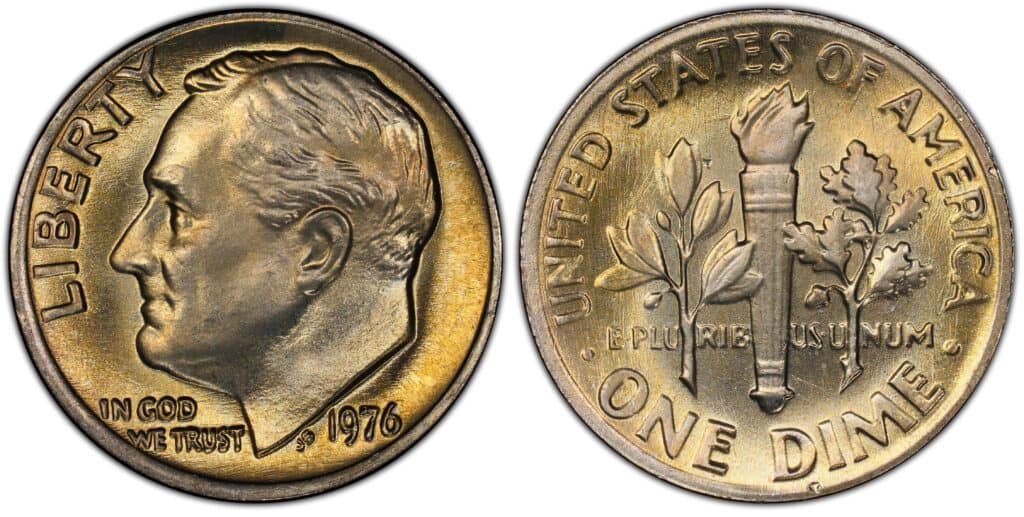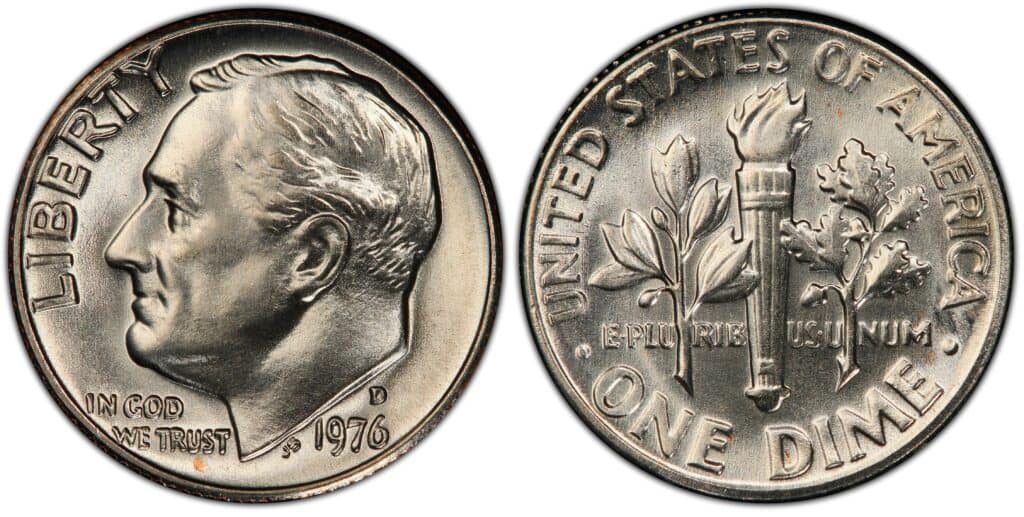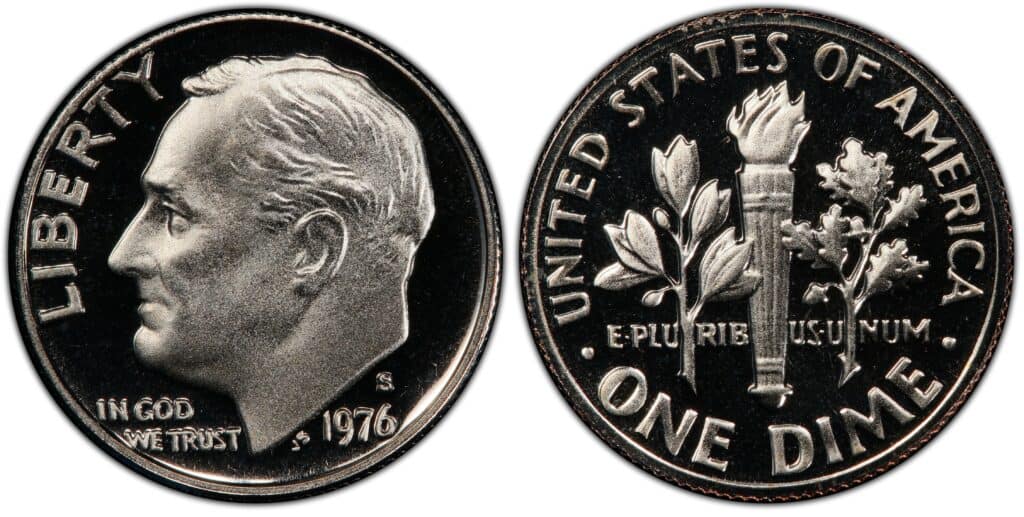What Is A 1976 Roosevelt Dime Made Of?
The 1976 Roosevelt dime is made of 91.67% copper and 8.33% nickel. Its core is made of solid copper while its surface is clad with nickel. The 1976 dime has a diameter of 17.9 mm and a weight of 2.27 grams.

When it comes to design, the 1976 dime features an image of left-facing Franklin Roosevelt who served as the 32nd President of the United States. On the obverse side, you’ll find the following inscriptions:
- LIBERTY
- IN GOD WE TRUST
- 1976 date
- JS initials (John Sinnock, the designer of the coin)
- Mint mark (if present)
On the reverse side, you’ll find a torch in the center, which symbolizes liberty. The torch is surrounded by an olive branch, which signifies peace, and the oak branch, which symbolizes strength and independence.
The following inscriptions include the following:
- E PLURIBUS UNUM
- UNITED STATES OF AMERICA
- ONE DIME
The Roosevelt dimes were first made in 1946, just a few months after Roosevelt passed away in 1945. As a way to honor the president who greatly contributed to the establishment of the March of Dimes organization, his bust appeared on the dime.
The dime is considered to be the smallest of all the U.S. coins minted today in terms of its thickness and diameter. The word dime came from the French word disme. It means tithe or “tenth part.”
The dimes were first introduced in 1796. From that year to 1965, the dime is dominantly made of silver and a little copper. The Coinage Act of 1965 caused the removal of silver for the dime. Nevertheless, the U.S. Mint issues a Silver Proof Set of dimes every year for collectors.
1976 Roosevelt Dime Varieties
The 1976 Roosevelt dimes come in various designs. They primarily differ in their mint mark. However, there are also those 1976 dimes that were made with errors, giving birth to a rare variety.
Here are some of the most common 1976 Roosevelt dime varieties.
1976-P Dime (No Mint Mark)
Year: 1976
Mint Mark: None
Edge: Reeded
Quantity produced: 568,760,000
Face Value: $0.10 USD
Price: $0.10 to $3.00 (or more)

When a dime is made in Philadelphia, it usually doesn’t have the mint mark, “P.”
1976-D Roosevelt Dime
Year: 1976
Mint Mark: D
Edge: Reeded
Quantity produced: 695,222,000
Face Value: $0.10 USD
Price: $0.10 to $3.00 (or more)

The 1976 dime with the D mark was made in Denver.
1976-S Roosevelt Dime
Year: 1976
Mint Mark: S
Edge: Reeded
Quantity produced: 4,149,000
Face Value: $0.10 USD
Price: $0.10 to $3.00 (or more)

The 1976 Roosevelt dime with an S mark was made in San Francisco.
1976 Roosevelt Dime errors
With lots of Roosevelt dimes produced, it is not difficult to see that there are dimes made in error. Here are some of the most common ones:
- Blank planchet – sometimes, the machine missed putting a design on the planchet, making it blank on both sides. You can still determine if it is a dime because of its size.
- Clipped planchet – because of a misfeed, the planchet shows a missing section.
- Missing clad layer – the dime is normally clad with nickel. As a result of an error, the nickel clad is missing and the dime shows its copper core.
- Broadstrike – the dimes with a broad strike error come with a smooth rim. Because the collar die failed, the struck image stretched out across the coin.
- Off-center strike – the struck image doesn’t align properly to the center.
The Roosevelt dime is one of the six major designs of the dime. Designs include the Draped Bust (1796–1807), Capped Bust (1809–1837), Seated Liberty (1837–1891), Barber (1892–1916), and Winged Liberty Head, Mercury (1916–1945).
The Roosevelt design was introduced in 1946 and it has been used to this day. Although it was made with an iconic image, it has met a lot of initial problems.
Chief Engraver John Sinnock designed Roosevelt’s bust that you now see on the dime. He created various designs and was rejected until one of his designs was accepted on January 6, 1946.
How Much Is A 1976 Roosevelt Dime Worth Today?
The face value of the 1976 Roosevelt dime is $0.10. Its melt value is also the same as its face value. If you’re going to sell your 1976 dime, it could only be sold for around $0.10 to $3. However, depending on the coin grade of your dime, you may be able to sell it for more. An MS-65 dime can be sold for $6.
Rarer 1976 dimes can be sold for a higher price. Usually, these coins are the ones made with errors. Since these errors are accidental, you get a unique dime making it rare. If you do a quick online search, a rare 1976 Roosevelt dime can be sold for as high as $300.
Like what was mentioned above, the U.S. Mint releases a Silver Proof Set of dimes annually for collectors. Usually, the price is a little bit higher than $100. If you have one of these sets, then you can sell them for a bigger price.
How Does The Grading System Work?
The Sheldon Scale is used by numismatists to provide a numerical value to coins. The Sheldon Scale goes from poor (P-1) to perfect mint state (P-1) (MS-70). Coins were originally evaluated using words to reflect their condition (Good, Fair, Excellent, Etc.). Unfortunately, coin collectors and dealers had different ideas about what each of these terms represent.
Professional numismatists joined together in the 1970s and established CoinGrading standards. These numismatists now assign grades at key places on the seventy-point scale, using the most regularly utilized numeric points in conjunction with the original adjective grade. The following are the most common coin grades:
-
-
- (P-1) Poor – Indistinguishable and probably damaged; if used, must have a date and mintmark; otherwise, rather battered.
- (FR-2) Fair – Nearly smooth, but without the damage that a coin graded Poor often possesses. The coin must have enough detail to be identified.
- (G-4) Fair – Inscriptions have merged into the rims in some areas, and important elements have been mostly erased.
- (VG-8) Very Good- A little weathered, but all of the primary design elements are visible, albeit faintly. There is little if any, central detail left.
- (F-12) Good – The item is very worn, yet the wear is even, and the overall design details stand out clearly. Rims are almost completely isolated from the field.
- (VF-20) Very Fine – Moderately weathered, with some finer features still visible. The motto or all letters of LIBERTY are readable. Both sides of the coin have entire rims that are separated from the field.
- (EF-40) Extremely Fine – Gently used; all gadgets are visible, and the most important ones are bold. The finer details are bold and clear, however, light wear may be seen.
- (AU-50) Uncirculated – Slight evidence of wear on the coin’s design’s high points; may have contact marks; eye appeal should be adequate.
- (AU-58) Uncirculated Choice – Slight traces of wear, no severe contact marks, almost full mint shine, and great eye appeal.
- (MS-60) Mint State Basal – Strictly uncirculated; no indication of wear on the coin’s highest points, but an unsightly coin with reduced luster, visible contact marks, hairlines, and other flaws.
- (MS-63) Mint State Acceptable – Uncirculated, but with contact scratches and nicks, little reduced shine, but otherwise appealing appearance. The strike is weak to average.
- (MS-65) Mint State Choice – Uncirculated with great mint shine, very little contact blemishes, and exceptional eye appeal. The strike is unusually severe.
- (MS-68) Mint State Premium Quality – Uncirculated with superb luster, no obvious contact marks to the naked eye, and exceptional eye appeal. The strike is quick and appealing.
- (MS-69) Almost Perfect Mint State – Uncirculated with perfect brilliance, a sharp and appealing strike, and extremely good eye appeal. A near-perfect coin with minor imperfections in the planchet, strike, and contact markings (seen only under 8x magnification).
- (MS-70) Mint State Perfect – Under 8x magnification, there are no tiny imperfections discernible; the strike is crisp, and the coin is perfectly centered on a beautiful planchet. Rarely seen on a coin, this coin is bright and whole, with original luster and exceptional eye appeal.
-
Where To Buy Or Sell 1976 Dimes?
You can buy or sell 1976 dimes online. eBay and Amazon are two of the top online marketplaces that you should try. There are also social networking sites such as Facebook, Instagram, and Twitter.
Aside from the Internet, you can visit coin shops, coin exchanges, antique shops, pawnshops, and collectors hubs to sell your 1976 dimes or buy one from them.
Whether you are buying or selling 1976 dimes, you need to be extra careful in choosing who you deal with. There are sellers who make outrageous claims and price their coins unrealistically high. If in doubt, always have an expert examine the coin.
FAQs
Did 1976 dimes have a mint mark?
Yes, the 1976 dimes have the mint mark of “D” and “S.” D stands for Dever and S refers to San Francisco. Dimes without a mint mark were produced in Philadelphia.
How much is a 1976 gold dime worth?
There is no 1976 gold dime. However, some private entities get a 1976 dime and coat it with gold, increasing its value. The 2016 W Mercury Centennial Gold Coin is the only official gold dime produced by the U.S. Mint. Only 125,000 gold dimes were released.
Is the 1976 dime rare?
No, the 1976 dime isn’t rare. You can easily find them on coin exchanges and shops. There were over 1.2 billion 1976 dimes produced, making it a common coin.
